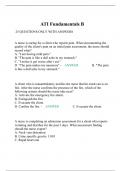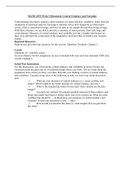Samenvatting
Samenvatting theorie Strategic Management - Hotel Management
Dit document bevat alle theorie van het boek 'Exploring Strategy' die je moet weten voor de strategic toets. De theorie is compact samengevat, en is daardoor direct toepasbaar op het bedrijf van jou module. Ik heb het gebruikt voor de opleiding International Hospitality Management op Hotel Managem...
[Meer zien]














